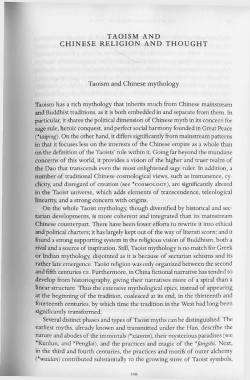Page 169 - The Encyclopedia of Taoism v1_A-L
P. 169
TAOISM AND
CHINESE RELIGION AND THOUGHT
Taoism and Chinese mythology
Taoism has a rich mythology that inherits much from Chinese mainstream
and Buddhist traditions, as it is both embedded in and separate from them. In
particular, it shares the political dimension of Chinese myth in its concern for
sage rule, heroic conquest, and perfect social harmony founded in Great Peace
(*taiping). On the other hand, it differs significantly from mainstream patterns
in that it focuses less on the interests of the Chinese empire as a whole than
on the definition of the Taoists' role within it. Going far beyond the mundane
concerns of this world, it provides a vision of the higher and truer realm of
the Dao that transcends even the most enlightened sage ruler. In addition, a
number of traditional Chinese cosmological views, such as immanence, cy-
clicity, and disregard of creation (see *COSMOLOGY), are significantly altered
in the Taoist universe, which adds elements of transcendence, teleological
linearity, and a strong concern with origins.
On the whole Taoist mythology, though diversified by historical and sec-
tarian developments, is more coherent and integrated than its mainstream
Chinese counterpart. There have been fewer efforts to rewrite it into ethical
and political charters; it has largely kept out of the way of literati scorn; and it
found a strong supporting system in the religious vision of Buddhism, both a
rival and a source of inspiration. Still, Taoist mythology is no match for Greek
or Indian mythology, disjointed as it is because of sectarian schisms and its
rather late emergence. Taoist religion was only organized between the second
and fifth centuries CE. Furthermore, in China fictional narrative has tended to
develop from historiography, giving their narratives more of a spiral than a
linear structure. Thus the extensive mythological epics, instead of appearing
at the beginning of the tradition, coalesced at its end, in the thirteenth and
fourteenth centuries, by which time the tradition in the West had long been
Significantly transformed.
Several distinct phases and types of Taoist myths can be distinguished. The
earliest myths, already known and transmitted under the Han, describe the
nature and abodes of the immortals (*xianren), their mysterious paradises (see
*Kunlun, and *Penglai), and the practices and magic of the *fangshi. Next,
in the third and fourth centuries, the practices and motifs of outer alchemy
(*waidan) contributed substantially to the growing store of Taoist symbols,
129

